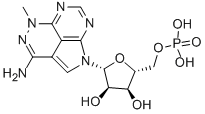CHEMICAL AND PHYSICAL PROPERTIES
| Solubility | McOH < 1 (mg/mL) |
|---|---|
| Stability/Shelf Life | Bulk: A sample stored at 60 °C for 30 days showed no decomposition (TLC or UV). Solution: A solution (.0156 mg/mL) in pH 9 carbonate - bicarbonate buffer showed no decomposition after 9 days (UV). |
SAFETY INFORMATION
| Signal word | Warning |
|---|---|
| Pictogram(s) |
 Exclamation Mark Irritant GHS07 |
| GHS Hazard Statements |
H302:Acute toxicity,oral H315:Skin corrosion/irritation H319:Serious eye damage/eye irritation H335:Specific target organ toxicity, single exposure;Respiratory tract irritation |
| Precautionary Statement Codes |
P261:Avoid breathing dust/fume/gas/mist/vapours/spray. P305+P351+P338:IF IN EYES: Rinse cautiously with water for several minutes. Remove contact lenses, if present and easy to do. Continuerinsing. |
COMPUTED DESCRIPTORS
| Molecular Weight | 400.28 g/mol |
|---|---|
| XLogP3 | -3.3 |
| Hydrogen Bond Donor Count | 5 |
| Hydrogen Bond Acceptor Count | 11 |
| Rotatable Bond Count | 4 |
| Exact Mass | 400.08963390 g/mol |
| Monoisotopic Mass | 400.08963390 g/mol |
| Topological Polar Surface Area | 189 Ų |
| Heavy Atom Count | 27 |
| Formal Charge | 0 |
| Complexity | 663 |
| Isotope Atom Count | 0 |
| Defined Atom Stereocenter Count | 4 |
| Undefined Atom Stereocenter Count | 0 |
| Defined Bond Stereocenter Count | 0 |
| Undefined Bond Stereocenter Count | 0 |
| Covalently-Bonded Unit Count | 1 |
| Compound Is Canonicalized | Yes |
PRODUCT INTRODUCTION
description
Triciribine Phosphate is the phosphate salt of the synthetic, cell-permeable tricyclic nucleoside triciribine with potential antineoplastic activity. Triciribine inhibits the phosphorylation, activation, and signalling of Akt-1, -2, and -3, which may result in the inhibition of Akt-expressing tumor cell proliferation. Akts are anti-apoptotic serine/threonine-specific protein kinases that phosphorylate and inactivate components of the apoptotic machinery, including Bcl-xL/Bcl-2-associated death promoter (BAD) and caspase 9.

